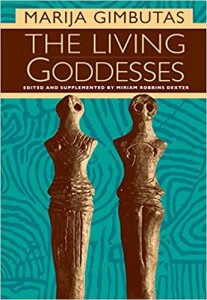 This text, published posthumously (four years after Gimbutas’ death), is the culmination of decades of research into the “civilization of the goddess,” in the author’s own words.
This text, published posthumously (four years after Gimbutas’ death), is the culmination of decades of research into the “civilization of the goddess,” in the author’s own words.
A Lithuanian native, Gimbutas moved to the United States in the 1940s, and held positions with both Harvard and the University of California, Los Angeles, during her nearly forty-year academic career. She devoted much of this time to the study of Europe’s prehistoric cultures, becoming extensively widely read (and known), and active in new archeological digs in eastern Europe. This experience gave rise to Gimbutas’ particular interest in Neolithic mythic/religious symbolism, which later spawned some of her more well known works, The Language of the Goddess and The Civilization of the Goddess.
Those works elicited no small amount of controversy among Gimbutas’ professional colleagues, as she theorized the existence of strong goddess-centric, matriarchal societies, which only later yielded to the better-known patrilineal Indo-European culture. This supposition flew in the face of much accepted study, and won Gimbutas both detractors and supporters.
There are two distinct halves to Living Goddesses: the first, in which Gimbutas examines physical and social evidence supporting her belief in extensive Neolithic goddess worship, and the second, wherein she traces the development of goddess worship in several Neolithic and Indo-European cultures, linking the goddesses to what modern aspects of them yet remain.
Gimbutas touches on a wide spectrum of physical evidence that lends credence to her belief that goddess worship was prevalent in Neolithic cultures, not all of which follows convention, but certainly seems plausible as presented. She first discusses images (both two- and three-dimensional) frequently found at Neolithic sites, of goddesses and associated animals, especially the goddess in her generative (bear, goat, fish) or death (snake, bird) aspects. Associated with the images are particular symbols, such as eggs, labyrinths or triangles, which can also be associated with birth and death.
She turns her attention in the next chapters to physical structures, such as tombs, temples and roundels (e.g., Avebury and Stonehenge). Gimbutas posits that tombs are quite womb-like in shape, especially when coupled with a birth canal-like passageway. She sees this, and the presence of the above images, as an intentional effort to evoke the goddess in both her death and rebirth aspects. Similarly, Gimbutas concludes that temples and roundels, because of their structure, votive content, and usual lack of settlement debris, were of a ceremonial nature, rather than fortifications, as has been generally assumed. As such, she concludes they were built to honor the goddess.
In the concluding chapter to the first half, Gimbutas links this physical evidence to the social structure of several Neolithic cultures: Etruscan, Iberian, Minoan, Northern Aegean and Celtic. These cultures were significant either for their matrilineal structure, or the social importance of women. She disputes the commonly held belief that patrilineal, hierarchical societies were the norm in these cultures, particularly with respect to Minoan society. This chapter provides the transition to the second half of the book, which focuses intently on mythology and religion, and deities in particular.
Gimbutas has chosen a mix of Neolithic and Indo-European cultures to demonstrate the growth, assimilation, and eventual decline (but persistence) of the goddess in religion. She focuses on the Minoan, Greek, Etruscan, Basque, Celtic, Germanic and Baltic cultures to demonstrate that growth and decline. While some aspects of the goddess(es) from several of the cultures persist to some small degree (e.g., Germanic Freyja and Celtic Brigid), the two most significant cultures are the Basque and Baltic, for their peoples’ beliefs persist even into this century. She provides concrete examples of ritual beliefs, songs and practices that Christianity and modernization have yet to entirely eradicate. Her description of the Baltic culture is particularly poignant, given that she herself was of Lithuanian descent.
Well written, and easy to read despite the richness and breadth of the material, this text is invaluable as an introduction to both Gimbutas and study of Neolithic goddess worship. Detailed footnotes, glossary and bibliography make further understanding and study a definite possibility which I hope readers will pursue.
(University of California Press, 1999)
